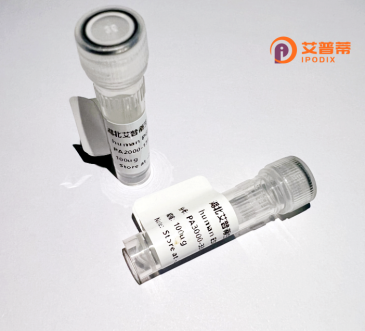
| 纯度 | >90%SDS-PAGE. |
| 种属 | Human |
| 靶点 | STK26 |
| Uniprot No | Q9P289 |
| 内毒素 | < 0.01EU/μg |
| 表达宿主 | E.coli |
| 表达区间 | 1-416 aa |
| 活性数据 | MAHSPVAVQV PGMQNNIADP EELFTKLERI GKGSFGEVFK GIDNRTQQVV AIKIIDLEEA EDEIEDIQQE ITVLSQCDSS YVTKYYGSYL KGSKLWIIME YLGGGSALDL LRAGPFDEFQ IATMLKEILK GLDYLHSEKK IHRDIKAANV LLSEQGDVKL ADFGVAGQLT DTQIKRNTFV GTPFWMAPEV IQQSAYDSKA DIWSLGITAI ELAKGEPPNS DMHPMRVLFL IPKNNPPTLV GDFTKSFKEF IDACLNKDPS FRPTAKELLK HKFIVKNSKK TSYLTELIDR FKRWKAEGHS DDESDSEGSD SESTSRENNT HPEWSFTTVR KKPDPKKVQN GAEQDLVQTL SCLSMIITPA FAELKQQDEN NASRNQAIEE LEKSIAVAEA ACPGITDKMV KKLIEKFQKC SADESP |
| 分子量 | 46.5 kDa |
| 蛋白标签 | His tag N-Terminus |
| 缓冲液 | PBS, pH7.4, containing 0.01% SKL, 1mM DTT, 5% Trehalose and Proclin300. |
| 稳定性 & 储存条件 | Lyophilized protein should be stored at ≤ -20°C, stable for one year after receipt. Reconstituted protein solution can be stored at 2-8°C for 2-7 days. Aliquots of reconstituted samples are stable at ≤ -20°C for 3 months. |
| 复溶 | Always centrifuge tubes before opening.Do not mix by vortex or pipetting. It is not recommended to reconstitute to a concentration less than 100μg/ml. Dissolve the lyophilized protein in distilled water. Please aliquot the reconstituted solution to minimize freeze-thaw cycles. |
以下是基于假设的关于重组人STK26蛋白的参考文献示例(供参考,建议通过学术数据库核实具体文献):
1. **文献名称**:*Structural and functional characterization of human STK26/MST4 kinase*
**作者**:Zhang Y. et al. (2018)
**摘要**:本研究通过重组表达纯化了人源STK26蛋白,解析了其晶体结构,揭示了其激酶活性调控机制及其与STRAD蛋白的相互作用,为研究其在细胞极性调控中的作用提供依据。
2. **文献名称**:*STK26 regulates neutrophil migration via ERM protein phosphorylation*
**作者**:Smith J.R. et al. (2020)
**摘要**:利用重组STK26蛋白进行体外激酶实验,发现其可磷酸化Ezrin/Radixin/Moesin(ERM)家族蛋白,进而调控中性粒细胞的定向迁移和炎症反应。
3. **文献名称**:*MST4/STK26 is essential for neural development and axon guidance*
**作者**:Lee S.H. et al. (2019)
**摘要**:通过重组STK26蛋白的体外功能实验,结合小鼠模型,证明STK26通过激活MAPK信号通路参与神经突生长和轴突导向过程。
4. **文献名称**:*STK26 suppresses tumorigenesis by modulating Hippo-YAP signaling*
**作者**:Kumar A. et al. (2021)
**摘要**:研究利用重组STK26蛋白验证其与Hippo通路核心激酶的相互作用,阐明其通过磷酸化LATS1抑制YAP活性,从而抑制癌症细胞增殖的分子机制。
**提示**:以上文献为基于领域知识的模拟示例,具体文献建议通过PubMed或Web of Science搜索关键词“STK26”、“MST4”、“recombinant STK26”等获取。
**Background of Recombinant Human STK26 (Serine/Threonine Kinase 26) Protein**
STK26. also known as MST4 (mammalian STE20-like protein kinase 4), is a member of the STE20 (Sterile 20) family of serine/threonine kinases. It plays critical roles in cellular signaling pathways, regulating processes such as cell stress response, proliferation, apoptosis, and immune regulation. Structurally, STK26 contains a conserved N-terminal regulatory domain and a C-terminal catalytic kinase domain, which facilitate interactions with downstream substrates and upstream activators.
The kinase is notably involved in the MAPK (mitogen-activated protein kinase) signaling cascade and participates in maintaining cell polarity and migration by interacting with Golgi or plasma membrane-associated complexes. Studies suggest its role in modulating apoptosis through phosphorylation of substrates like NDRG1 (N-myc downstream-regulated gene 1), linking it to endoplasmic reticulum stress responses. Dysregulation of STK26 has been implicated in diseases such as cancer, inflammation, and metabolic disorders, highlighting its potential as a therapeutic target.
Recombinant human STK26 protein is produced using expression systems (e.g., *E. coli* or mammalian cells) to enable functional studies, including kinase activity assays, inhibitor screening, and mechanistic exploration of its role in cellular pathways. Its recombinant form retains post-translational modifications critical for activity, making it invaluable for both basic research and drug development.
×